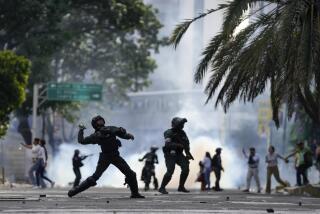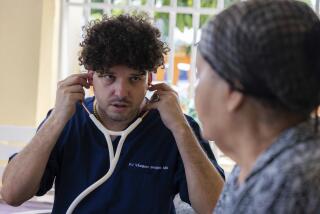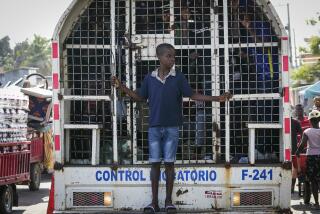Thousands From Dominican Republic Brave Stormy Seas for Chance at Better Life
- Share via
SAN JUAN, Puerto Rico — Jammed into an open boat with other desperate Dominicans, Ramon Diaz Perez battled through a tropical storm to get to Puerto Rico, part of a new wave of boat people who are risking their lives to have better ones.
“It was a storm of water, where the sea was wild and proud and the waves were way above us,” Diaz Perez said in a dingy holding cell for aliens on San Juan’s waterfront. “Right then it was really tough.
“It’s a trip that only someone who knows nothing about it would make,” said the 31-year-old mechanic who left behind a wife and four children when he sailed from the Dominican Republic to Puerto Rico early in 1988.
Despite the dangers, thousands of Dominicans gamble on surviving the 95-mile trip across the Mona Passage, the turbulent channel between Puerto Rico and its western neighbor.
Since 1986, increasing numbers have tried to escape the slumping Dominican economy, its 60% inflation and 25% unemployment.
“It’s an enormous problem,” said Capt. William Caster, U.S. Coast Guard commander for the Greater Antilles. “It’s costing the United States a lot of money, and it’s costing the Dominicans a lot of people, a lot of dead bodies.”
Authorities recovered the bodies of at least 31 Dominicans off western Puerto Rico in 1988, including 19 in December alone when their overloaded boats, called yolas , capsized.
Because currents sweep bodies back toward the Dominican coast, the exact death toll will never be known.
“We know it must be in the hundreds,” said James Walker, district director of the Immigration and Naturalization Service. “It has to be. We know they come over here in 5-foot seas, in boats with 4 inches of freeboard (the gap between the waterline and the deck).
“That means they have to be bailing the whole time. Sometimes they just aren’t going to make it.”
The new refugees increasingly are felt in Puerto Rico, where there are at least 175,000 illegal Dominicans, an estimated 5% of the population, Walker said.
But Puerto Rico is mainly a steppingstone to major U.S. cities, where Dominicans are a growing percentage of the Latino population.
For example, Dominicans are the fastest-growing Latino group in the New York area, according to a December report by the Latino Commission of Tri-State.
“Combined heavy immigration and rapid natural growth are expected to account for an estimated fourfold expansion of the Dominican community,” bringing Dominicans in the area to 636,000 by the year 2000, the report said.
Authorities said they knew of five major Dominican smuggling rings. U.S. officials want a treaty with the Dominican Republic, Caster said, to let the Coast Guard halt vessels on the open sea if it is suspected that they are bearing illegal aliens to the United States.
To stem the flood, the Border Patrol opened its first station outside the continental United States in October, 1987, at Aguadilla, on Puerto Rico’s northwest corner.
Agents have detained at least 2,931 aliens since then. They average some 500 detentions monthly during the winter, when calmer weather means more voyages.
Walker said Dominican deportations have quadrupled from 1985 to a projected 6,000 in the 1989 fiscal year, which began in October. However, authorities estimated that they were only halting up to 20% of the aliens.
Flanked by three other Dominican men, Diaz Perez described his two-day trip in a story U.S. officials said was typical.
Diaz Perez said he left on a February night from a beach near Miches, on the northeast Dominican coast. He knew none of the 40 people--almost all men--in the 20-foot yola powered by an outboard motor.
He said he paid about $320--equivalent to several months’ wages.
The boat pounded through a storm, with many passengers violently seasick and bailing most of the time. The vessel halted at Desecheo Island in the Mona Passage, then landed in the early morning on an Aguadilla beach.
Diaz Perez clambered up a cliff and fled on foot. Unable to find work, he said he stayed with a friend until Border Patrol agents arrested him in September.
“I’m here for my kids, not for me,” he said. “I took the yola for them.”
More to Read
Sign up for Essential California
The most important California stories and recommendations in your inbox every morning.
You may occasionally receive promotional content from the Los Angeles Times.










